LED Billboard Market Research, 2032
The global led billboard market size was valued at $3,554.2 million in 2022, and is projected to reach $9,795.2 million by 2032, growing at a CAGR of 10.8% from 2023 to 2032. The global LED billboard market growth is driven by factors such as shift towards digital advertising and growing demand for real-time content. However, high costs and availability of alternatives restrict market growth. On the contrary, expansion opportunities in emerging markets and integration of smart technologies are expected to offer new opportunities in the coming years.
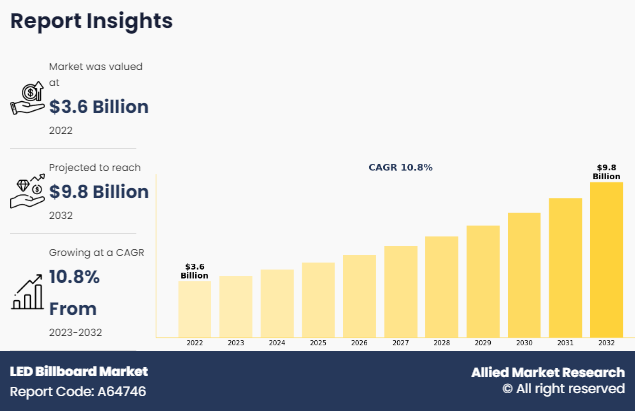
An LED billboard is a sort of outdoor promotional display that uses light-emitting diodes (LEDs) to generate colorful and dynamic images. In contrast to traditional stationary billboards, LED billboards are capable of showing many advertisements in cycles, allowing marketers to offer a wide range of materials in a single space. These billboards are often made of an organized arrangement of LED modules that produce high-resolution pictures and movies, making them extremely successful in capturing audience attention, particularly in high-traffic locations. LED billboards give advertisers greater control and versatility over their advertising since information is refreshed remotely and in real-time, allowing timely promotions and tailored campaigns.
Key Takeaways
- In 2022, on the basis of type, the full color segment was the highest contributor to the LED billboard market.
- In 2022, on the basis of application, the outdoor segment was the highest contributor to the LED billboard market.
- According to end user, the advertising & media segment generated the highest revenue in 2022 and is likely to grow at a substantial rate during the forecast period.
- By region, Asia-Pacific was the major revenue contributor in 2022 and is estimated to grow at a significant CAGR during the forecast period.
Market Overview
LED billboards are also noted for their energy economy and durability since they use less electricity than traditional light bulbs and are built to survive extreme weather conditions. In the commercial sector, LED billboards have emerged as a contemporary and effective outdoor advertising, generating brand exposure and interaction in an increasingly information-driven age.
The growing emphasis on digital advertising has proved to be a key growth factor for the LED billboard market. As businesses become more aware of the limits of conventional advertising methods, they are turning to digital platforms for marketing purposes. LED billboards provide a dynamic and eye-catching solution to conventional advertising, allowing marketers to show bright and interesting material that effectively attracts the audience's attention. Moreover, the versatility of LED billboards allows marketers to alter information remotely as well as in real-time, thereby keeping campaigns current and up to date. This versatility attracts fast-paced customers in today’s landscape, where trends and messages shift quickly. Furthermore, LED billboards' ability to appeal to specific audiences depending on location, time of day, and demographics increases their efficacy and ROI for marketers. As a consequence, rising demand for digital marketing solutions is pushing the use of LED billboards in a variety of sectors, fostering market development and expansion potential.
Increasing urbanization is a key development factor for the LED billboard market. Cities have grown into centers of economic activity, social interchange, and consumption as the world's urbanization accelerates. As urban populations grow, so does the requirement for efficient advertising solutions that attract the interest of busy urban population. Owing to their vibrant and eye-catching character, LED billboards are an appealing option for advertisers looking to interact with metropolitan consumers. These electronic displays stand out in the bustling cityscape, presenting bright and dynamic material that appeals to pedestrians. Furthermore, the high density of people in metropolitan areas results in increased foot and vehicular activity, maximizing the ability to be seen and reach LED signs.
Advertisers see the strategic importance of targeting urban consumers and are expanding their investment in LED billboard advertisements to take advantage of this demographic change. As urbanization continues unrestrained, usage of LED billboards is likely to skyrocket, boosting LED billboard market demand and creating lucrative prospects for industry participants.
The large initial investment needed to deploy LED billboards is a significant growth constraint for the LED billboard business. Setting up an LED billboard infrastructure is expensive, involving the acquisition of LED panels, installation fees, and investments in supporting infrastructure including power supplies and content management software. These initial costs might be prohibitively expensive for firms, particularly small and medium-sized organizations (SMEs), restricting their capacity to enter the LED billboard market. The intricacy of LED technology, as well as the specialized abilities required for maintenance and setup, all add to the substantial upfront cost barrier. As a result, prospective financiers view LED billboards as a dangerous investment, especially in areas with unclear economic or regulatory contexts.
To overcome this constraint, creative finance methods such as leasing agreements or cost-sharing agreements between LED billboard operators and advertisers are required. Furthermore, continued attempts to decrease the expense of LED technology and improve installation processes are expected to help make LED billboards more affordable and appealing to a larger variety of advertisers, opening up new market development potential.
Competition from alternative advertising media is a significant growth constraint for the LED billboard industry. In today's technologically driven advertising scene, LED billboards are up against intense competition from internet ads, social networking marketing, and smartphone advertising. These platforms provide marketers with highly targeted and customizable advertising options, sometimes at a lesser cost than conventional outdoor advertising channels such as LED billboards. Furthermore, the quantifiable and identifiable aspect of digital advertising enables marketers to evaluate and optimize campaigns in real-time, maximizing return on investment. As a result, firms devote a large amount of their advertising expenditures to digital platforms, limiting the funding available for LED billboard initiatives. In addition, the spread of ad-blocking software and consumer dissatisfaction with traditional advertising strategies add to the fierce competition on LED billboards.
To address this limitation, LED billboard operators have to distinguish their offers by emphasizing the distinct advantages of outdoor marketing, such as extensive reach, prominent placement, and brand awareness-building capabilities. Furthermore, employing data analytics and latest content tactics helps LED billboards stay relevant as well as competitive in today's congested advertising marketplace, resulting in market development and expansion.
Segments Overview
The LED billboard market is segmented into type, application, end user, and region. Depending on the type, the market is segregated into monochrome and full color. Based on application, the market is bifurcated into indoor and outdoor. On the basis of end user, it is fragmented into advertising & media, government, sports & entertainment, and others. Region wise, it is analyzed across North America (the U.S., Canada, and Mexico), Europe (Germany, UK, France, Italy, Spain, and rest of Europe), Asia-Pacific (China, Japan, India, Australia, South Korea, and rest of Asia-Pacific), Latin America (Brazil, Argentina, and rest of Latin America), and Middle East & Africa (Saudi Arabia, South Africa, United Arab Emirates, and rest of Middle East & Africa).
By Type
According to LED billboard market statistics, on the basis of type, the full color segment dominated the market in 2022 and is expected to continue this trend during the forecast period owing to their capacity to provide bright and compelling visual experiences. With improvements in LED lighting technology, full-color screens now provide rich, dynamic material with a high level of resolution, assuring vividness and precision even at a considerable distance. This adaptability enables advertisers to display compelling multimedia material including films, animations, and graphics, thereby attracting the audience's interest.
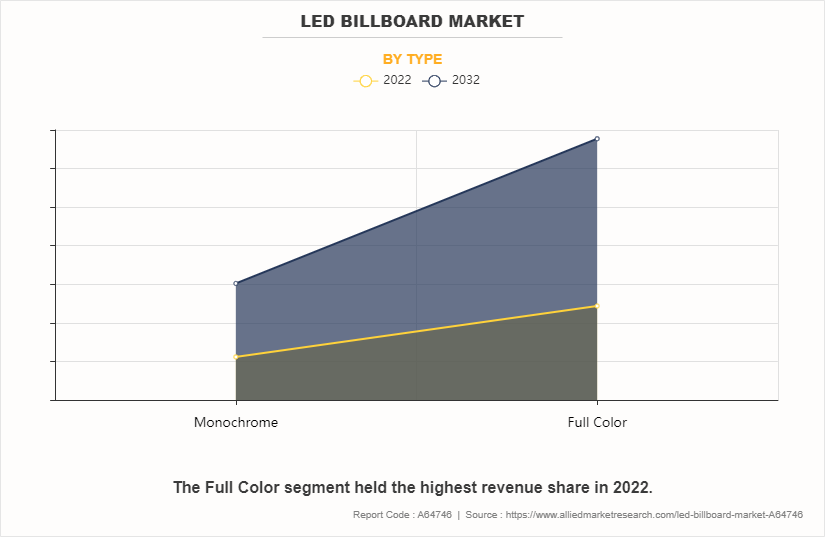
By Application
On the basis of application, the outdoor segment dominated the market in 2022 and is expected to continue this trend during the LED billboard market forecast period. Outdoor LED billboards are utilized extensively for marketing, promotion, and informative displays in high-traffic locations including motorways, city centers, stadiums, and shopping malls. Their capacity to survive a variety of climates while displaying bright, eye-catching material makes them essential for outdoor marketing campaigns.
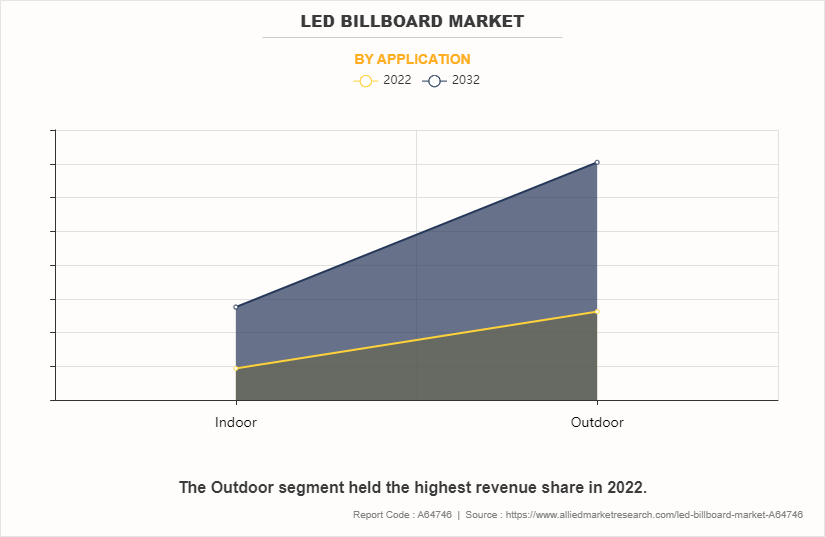
By End User
Depending on the end user, the advertising & media segment led the market in 2022 and is expected to maintain this trend during the forecast period. LED billboards provide unrivaled adaptability and exposure, which makes them the top choice for advertisers looking to engage viewers with innovative and visually appealing content. Their capacity to display bright pictures, videos, and animations in excellent resolution, along with configurable planning and remote management of content, allows advertisers to adapt messages and campaigns more successfully.
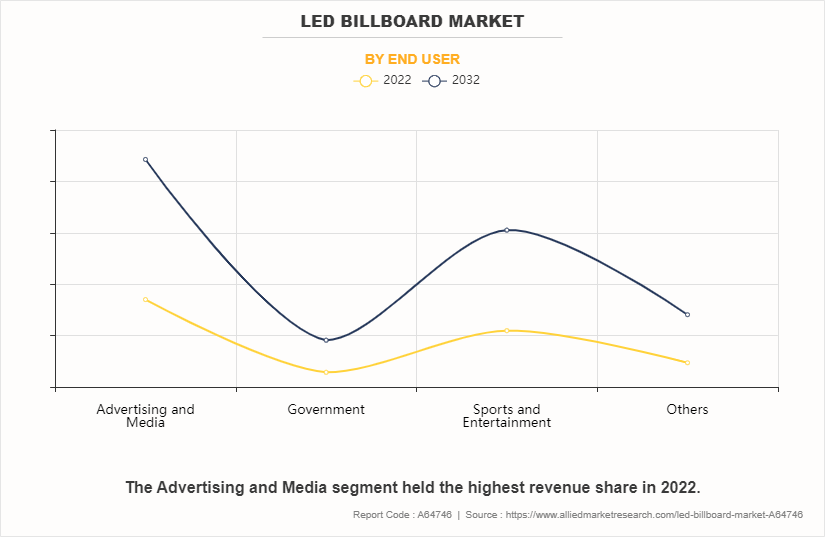
By Region
Region-wise, Asia-Pacific dominated the market in 2022 and is expected to dominate the market during the forecast period. Rapid urbanization and economic expansion in China, India, and Japan have resulted in greater growth in infrastructure including a rise in outdoor advertising spending. As a result, there is a huge need for LED billboards to meet the expanding advertising demands of businesses and organizations. Furthermore, technical improvements and manufacturing capacities in the area have reduced the cost and accessibility of LED billboards, driving market expansion.
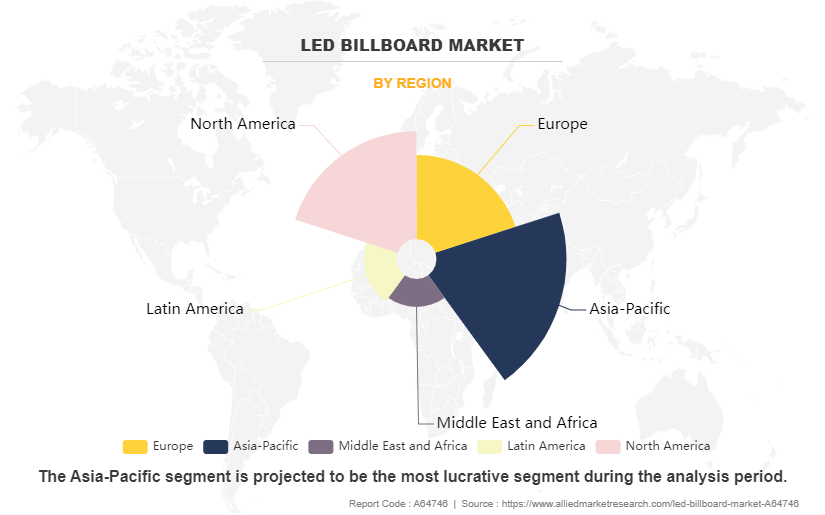
Competitive Analysis
Players operating in the LED billboard market have adopted various developmental strategies to expand their LED billboard market share, increase profitability, and remain competitive in the market. The key players profiled in this report include Daktronics, Barco, Absen, Unilumin, Watchfire, Liantronics, Leyard, Sansitech, Lighthouse, and Ledman
Recent Developments
- In November 2023, Liantronics expanded its manufacturing facilities and warehouse in U.S. to provide quicker service its clients .
- In October 2023, Ledman collaborated with WG Tech to launch the world’s first PM Glass Substrate Micro LED display screen.
Key Benefits For Stakeholders
- This report provides a quantitative analysis of the market segments, current trends, estimations, and dynamics of the led billboard market analysis from 2022 to 2032 to identify the prevailing led billboard market opportunities.
- The market research is offered along with information related to key drivers, restraints, and opportunities.
- Porter's five forces analysis highlights the potency of buyers and suppliers to enable stakeholders make profit-oriented business decisions and strengthen their supplier-buyer network.
- In-depth analysis of the led billboard market segmentation assists to determine the prevailing market opportunities.
- Major countries in each region are mapped according to their revenue contribution to the global market.
- Market player positioning facilitates benchmarking and provides a clear understanding of the present position of the market players.
- The report includes the analysis of the regional as well as global led billboard market trends, key players, market segments, application areas, and market growth strategies.
LED Billboard Market Report Highlights
| Aspects | Details |
| Market Size By 2032 | USD 9.8 billion |
| Growth Rate | CAGR of 10.8% |
| Forecast period | 2022 - 2032 |
| Report Pages | 230 |
| By Type |
|
| By Application |
|
| By End User |
|
| By Region |
|
| Key Market Players | Lighthouse, Daktronics, Ledman, Leyard, Sansitech, Watchfire, Barco, Absen, Unilumin, Liantronics |
Analyst Review
According to the CXOs, there is a considerable trend toward digital advertising, spurred by LED billboards' adaptability and flexibility as opposed to classic static billboards. This trend is fueled further by advances in LED technology, which result in greater clarity displays, more energy economy, and enhanced longevity, making LED billboards more appealing to marketers. In addition, rising demand for outdoor marketing, particularly in cities and close to highways, is supporting the growth of the global LED billboard market. Furthermore, the combination of LED billboards using intelligent technologies like AI-driven content optimization and real-time target audience creates new options for personalized and engaging advertising campaigns.
Furthermore, increased development of infrastructure investments, particularly in emerging nations, provides attractive growth prospects for LED billboard makers and advertisers seeking to enter new markets. As a whole, with continued technical improvements and an increasing need for digital advertising strategies, the LED billboard industry is expected to expand rapidly in the coming years.
The LED billboard market was valued at $3,554.2 million in 2022 and is projected to reach $9,795.2 million by 2032, registering a CAGR of 10.8% from 2023 to 2032.
The LED billboard market registered a CAGR of 10.8% from 2023 to 2032.
Raise the query and paste the link of the specific report and our sales executive will revert with the sample.
The forecast period in the LED billboard market report is from 2023 to 2032.
The top companies that hold the market share in the LED billboard market include Daktronics, Barco, Absen, and Unilumin.
The LED billboard market report covers segmentation based on type, application, and end user.
Region wise, Latin America is estimated to register the highest CAGR of 12.4% from 2023 to 2032.
Post-COVID-19, the LED billboard market is witnessing new heights of growth and is recovering from its losses. The increase of advertising and media marketing in the developing countries and high demand for outdoor advertisement by commercial companies is influencing the growth of the LED billboard market.
Loading Table Of Content...
Loading Research Methodology...



